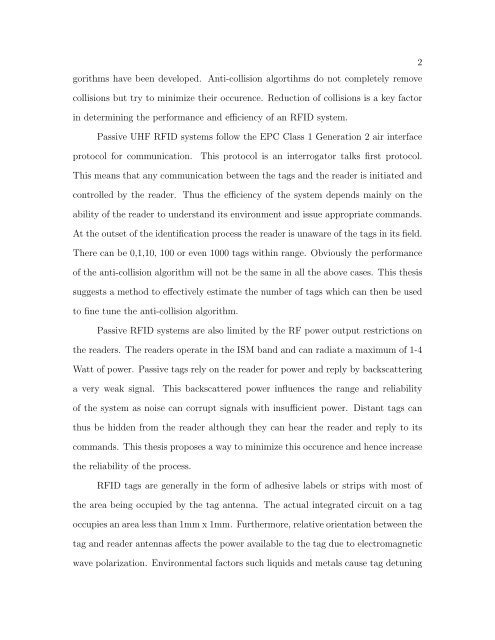utilizing physical layer information to improve rfid tag
utilizing physical layer information to improve rfid tag
utilizing physical layer information to improve rfid tag
Create successful ePaper yourself
Turn your PDF publications into a flip-book with our unique Google optimized e-Paper software.
gorithms have been developed. Anti-collision algortihms do not completely remove<br />
collisions but try <strong>to</strong> minimize their occurence. Reduction of collisions is a key fac<strong>to</strong>r<br />
in determining the performance and efficiency of an RFID system.<br />
Passive UHF RFID systems follow the EPC Class 1 Generation 2 air interface<br />
pro<strong>to</strong>col for communication. This pro<strong>to</strong>col is an interroga<strong>to</strong>r talks first pro<strong>to</strong>col.<br />
This means that any communication between the <strong>tag</strong>s and the reader is initiated and<br />
controlled by the reader. Thus the efficiency of the system depends mainly on the<br />
ability of the reader <strong>to</strong> understand its environment and issue appropriate commands.<br />
At the outset of the identification process the reader is unaware of the <strong>tag</strong>s in its field.<br />
There can be 0,1,10, 100 or even 1000 <strong>tag</strong>s within range. Obviously the performance<br />
of the anti-collision algorithm will not be the same in all the above cases. This thesis<br />
suggests a method <strong>to</strong> effectively estimate the number of <strong>tag</strong>s which can then be used<br />
<strong>to</strong> fine tune the anti-collision algorithm.<br />
Passive RFID systems are also limited by the RF power output restrictions on<br />
the readers. The readers operate in the ISM band and can radiate a maximum of 1-4<br />
Watt of power. Passive <strong>tag</strong>s rely on the reader for power and reply by backscattering<br />
a very weak signal. This backscattered power influences the range and reliability<br />
of the system as noise can corrupt signals with insufficient power. Distant <strong>tag</strong>s can<br />
thus be hidden from the reader although they can hear the reader and reply <strong>to</strong> its<br />
commands. This thesis proposes a way <strong>to</strong> minimize this occurence and hence increase<br />
the reliability of the process.<br />
RFID <strong>tag</strong>s are generally in the form of adhesive labels or strips with most of<br />
the area being occupied by the <strong>tag</strong> antenna. The actual integrated circuit on a <strong>tag</strong><br />
occupies an area less than 1mm x 1mm. Furthermore, relative orientation between the<br />
<strong>tag</strong> and reader antennas affects the power available <strong>to</strong> the <strong>tag</strong> due <strong>to</strong> electromagnetic<br />
wave polarization. Environmental fac<strong>to</strong>rs such liquids and metals cause <strong>tag</strong> detuning<br />
2
















